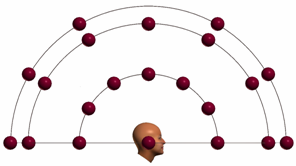Spectral Cues in Auditory Localization with Cochlear Implants (CI HRTF)

Objective
Bilateral use of current cochlear implant (CI) systems allows for the localization of sound sources in the left-right dimension. However, localization in the front-back and up-down dimensions (within the so-called sagittal planes) is restricted as a result of insufficient transmission of the relevant information.
Method
In normal hearing listeners, localization within the sagittal planes is mediated when the pinna (outer ear) evaluates the spectral coloring of incoming waveforms at higher frequencies. Current CI systems do not provide these so-called pinna cues (or spectral cues), because of behind-the-ear microphone placement and the processor's limited analysis-frequency range.
While these technical limitations are relatively manageable, some fundamental questions arise:
- What is the minimum number of channels required to encode the pinna cues relevant to vertical plane localization?
- To what extent can CI listeners learn to localize sound sources using pinna cues that are mapped to tonotopic regions associated with lower characteristic frequencies (according to the position of typically implanted electrodes)?
- Which modifications of stimulation strategies are required to facilitate the localization of sound sources for CI listeners?
Application
The improvement of sound source localization in the front-back dimension is regarded as an important aspect in daily traffic safety.
Funding
FWF (Austrian Science Fund): Project #P18401-B15
Status
Finished in Sept. 2010
Subprojects
- ElecRang: Effects of upper-frequency boundary and spectral warping on speech intelligibility in electrical stimulation
- SpecSens: Sensitivity to spectral peaks and notches
- Loca-BtE-CI: Localization with behind-the-ear microphones
- Loca Methods: Pointer method for localizing sound sources
- Loca#Channels: Number of channels required for median place localization
- SpatStrat: Development and evaluation of a spatialization strategy for cochlear implants
- HRTF-Sim: Numerical simulation of HRTFs